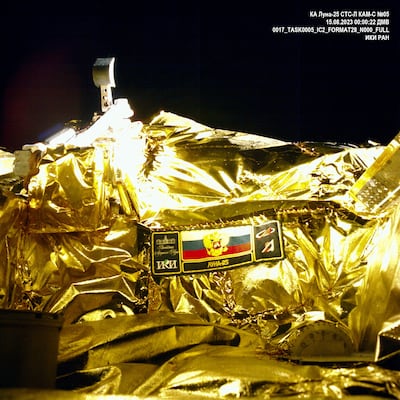India and Russia will attempt to land on the lunar surface next week, in the same region of the south pole.
The spacecraft are expected to arrive within days of each other and will study an area of the Moon not previously explored.
Russia’s Luna-25, the country’s first Moon mission in 50 years, blasted off into space on August 10 and entered lunar orbit on Wednesday, with a landing attempt expected on August 21.
India launched its Chandrayaan-3 mission on July 14. The Vikram lander separated from the Chandrayaan-3 spacecraft on Wednesday and a touchdown attempt will reportedly be made on August 23.
There is a renewed interest in the Moon as space agencies plan to send astronauts to its surface again and companies compete for contracts worth millions.
What is special about the lunar south pole?
The lunar south pole is of particular interest to space agencies because of the resources it offers, according to Dr Dimitra Atri, an astrophysicist at New York University Abu Dhabi.
“Observations from the lunar orbit indicate that these regions most likely have ice, which has been deposited by meteorites over several billion years,” he said.

“Because this region is not directly exposed to sunlight, the ice is preserved, unlike other regions which were explored during the Apollo era [near the equator] where it would quickly sublimate [from ice directly to water vapour].
“This pristine ice is of great scientific significance because it is a record of the more than four-billion-year history of the solar system.”
Race to the Moon
The US and China are also working on missions that will land in the same region.
They are planning to build a human base on the Moon and from there to eventually launch astronauts to Mars.
"Additionally, since agencies around the globe are thinking about establishing permanent human bases on the Moon, ice can help with human habitation and can be used to produce rocket fuel for missions to Mars and elsewhere," Dr Atri said.
While the south pole offers scientific benefit, the urgency to get there this decade could also be politically motivated.
It is reminiscent of the Cold War era when the former Soviet Union and the US were in a space race and competed over who would send the first astronaut into orbit and missions to the Moon.
Cosmonaut Yuri Gagarin became the first human being in space in 1961, the uncrewed Luna-2 mission by the Soviet Union was the first to land on the lunar surface in 1959 and the Apollo 11 mission by the US was the first human landing on the Moon, in 1969.
For a long time, only the US and former Soviet Union had been able to land on the Moon. China was the latest country to do so, in 2013.
Now, as China speeds towards becoming a global space power, the US is keeping a close eye.
"It is a fact: we're in a space race," Nasa administrator Bill Nelson told Politico in an interview in January.
"And it is true that we better watch out that they don't get to a place on the Moon under the guise of scientific research. And it is not beyond the realm of possibility that they say, 'Keep out, we're here, this is our territory.'"
Russia and India's Moon ambitions
This is India's second attempt at landing softly, after the first one, Chandrayaan-2, crashed on the surface in 2019.
India is a signatory of the US-led Artemis Accords, an international agreement that outlines peaceful exploration of the Moon.
Russia has not signed the accords so far and its previous director general said that the agreement was "too US-centric".
Instead, the country has tried to increase its partnership with China.
It was supposed to be working on the International Lunar Research Station with China, although not many updates on the partnership have been announced.





